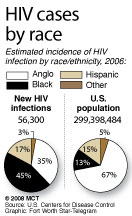 MCT Campus
MCT CampusSome important topics that are covered in middle school and maybe again in high school are worth repeating time and again. Some people don’t seem to get it. HIV and AIDS are real and concerning realities for many people not only over seas but also in America.
One would think with so much public knowledge about the issue that the numbers of newly infected people would be decreasing, but sadly that is not the case. More than one million people are living with HIV or AIDS in America and this figure skyrockets to more than 33 million worldwide, according to www.aids.gov.
It’s important for minority groups, gay and bisexual men and women to acknowledge the reality that they are at a higher risk for infection, according to a new analysis completed by the Centers for Disease Control and Prevention.
The study showed that young black gay men, black women and white gay men in their 30s and 40s were significantly more likely to be newly infected with HIV than other groups in the United States.
The most shocking figure discovered during the investigation showed that while blacks only make up about 12 percent of the U.S. population, they made up 49 percent of new cases in 2006. For black women, the study showed them to be 15 times more likely to contract HIV than white women.
While it is important to do this research to get this information out there, I have yet to see a substantive change in the way that HIV and AIDS is talked about amongst my friends, coworkers, and even people in academia.
The adage that tells us what everybody else knows is not worth knowing may hold true for many circumstances, but this is not one of them.
If you’ve already heard these statistics, they are worth hearing again. HIV needs to be discussed in a way that brings in race, sexual orientation and gender to the forefront of the discussion. With this knowledge in hand, we need to target education campaigns and services that reflect the reality of who is at a higher risk of infection.
If America is serious in addressing this epidemic, then we need to provide the resources to make it happen and make sure that the people identified by the CDC study are not left as an afterthought when it comes to education and prevention.
The Residence Hall Association recently hosted a Condom Fashion Show and in between the wardrobe changes, they asked questions about HIV and STIs. One of the questions asked, when two people are going to have sex, “who is more responsible for providing the birth control, the man or the woman?”
A female Latina student raised her hand and responded confidently that, in her opinion, it is the woman’s responsibility.
I was shocked and horrified that someone would hold this kind of mentality. I realized she had underscored the real issue at hand: we won’t be able to prevent the spread of HIV or other STIs unless we make sure to educate everybody on their personal role and responsibility to end it.
There is a serious need for education reform in the sector of HIV and STI awareness and, until the government is willing to provide the resources and funding for it, we will continue to suffer through this epidemic.
8212;This column does not necessarily reflect the opinion of The Daily Aztec.









